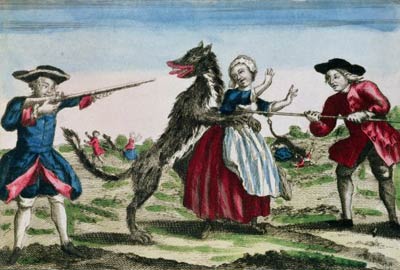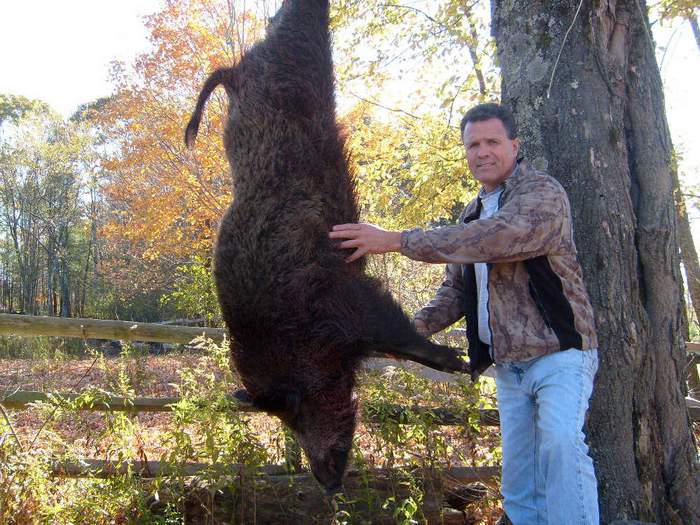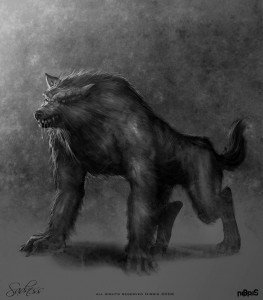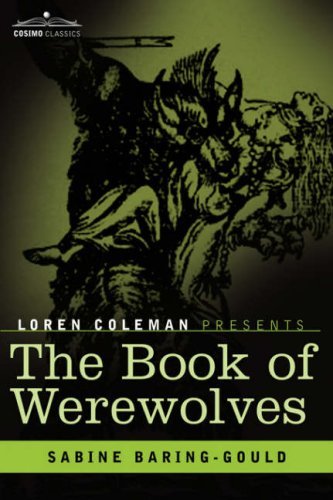“It Looked Like A Werewolf!”
Posted by: Loren Coleman on October 29th, 2008
The Beast of Gevaudan, published by Basset, 1764. Musee Nat. des Arts et Traditions Populaires, Paris, France.
New to the file on “unexpected animals,” there is the one about the at-first misidentified critter found recently in Massachusetts.
Massachusetts State Police say a 200-pound Russian wild boar was euthanized after being struck by a vehicle on a road in Lancaster last week.
Chester H. Hall III of Royalston displays what he believes is a wild Russian boar that was hit by a vehicle on Route 2 in Shirley. (Photo: George Barnews, Worcester Telegram)
A wild boar in the Bay State was a big surprise to state wildlife experts. They say although some wild boars are known to live in northern New England, there never has been a native population of feral swine in Massachusetts.
The animal wandered down Route 2, was apparently struck by a vehicle and had to be euthanized, out of concern for public saftey.
Around 6:30 a.m. Wednesday, October 22, 2008, a state trooper happened upon the creature. He thought the animal was a “juvenile moose,” at first glace, said David Procopio, spokesman for Massachusetts State Police.
The large, feral pig was injured in the hind end and legs by an unknown vehicle and driver.
“There was concern that it would walk back into the roadway, and out of concern for public safety and the concern of the animal a choice was made to euthanize it,” Procopio said.
State police set up a rolling road block in the breakdown lane of Route 2 to slow traffic as the pig was put down with a gunshot.
Chester H. Hall III of Royalston was contacted to take away the carcass. Hall is known locally as a coyote hunter. He said he was offered what he was told was a pig for coyote bait.
“I went to pick up a wild pig and there was a full-blown Russian boar,” he said.
The boar was about 200 pounds, dark brown and slightly reddish in color. Hall said it looked to him like the classic image of a werewolf with a hump on its back and a long snout. The animal had tusks but they were barely visible because they were broken.
The modern image of a werewolf actually does look similar to the overall body design of a wild boar. Above is the Wii werewolf from Nibris, a game studio based in Cracow, Poland, to be found in their game entitled Sadness.
Hall said he was surprised because wild boars are not supposed to be found in Massachusetts.
“I spoke to a biologist and he said it’s only the third time he has heard of one in Massachusetts,” he said.
Hall said it is unclear where the boar may have come from. He said it might have been living in the Oxbow Wildlife area not far from where it was killed.
There are wild boar populations in New Hampshire, Vermont and Pennsylvania, but the animals are rarely seen in other parts of the Northeast.
Russian wild boars were introduced to New Hampshire in the 1890s at the 20,000-acre Corbin wild game preserve. Hall said some escaped when a fence was blown down during a hurricane.
Hall said he has hunted bear, but he would not want to meet a wild boar up close.
“They can be very nasty and aggressive,” he said. “I would rather see a 500-pound bear in the woods than a boar.”
Hall said most people who hunt boars do so from a tree stand.
The animal hit on Route 2 had been in good health, although it had ticks all over it. Hall said the boar had been feeding on apples, chokecherries and acorns.
He said that after seeing that it was a large boar, rather than a pig, he changed his mind about using it for coyote bait. He said it will now become steaks, pork chops and sausage.
Monte D. Chandler of the U.S. Department of Agriculture in Amherst said there are no feral pigs, feral swine or Russian boar populations in Massachusetts, Connecticut and Rhode Island.
“If they are present, they are something that escaped from someone,” he said.
Lisa Capone, a spokeswoman for the state Executive office of Energy and Environmental Affairs, agreed with Chandler’s assessment.
“There is no native population of boars or feral hogs in Massachusetts,” she said.
In other parts of the country there are large feral swine populations.
“The USDA is monitoring them throughout the United States,” Mr. Chandler said.
Wild boars, like the one killed on Route 2, can cause significant damage to crops and other plants, even uprooting small trees. Their aggressive behavior also poses a danger to people who encounter them in the wild.
Chandler said officials would determine if there is a population of wild swine in the state — if there were reports of the wild animals uprooting plants. The reports would then be investigated to determine if there are wild swine and if they are reproducing in the wild.
“Up to this point there haven’t been any reports,” he said.
“By virtue of seeing a hog you’re going to want to avoid it,” said Chandler, spokesman for the U.S. Department of Agriculture in Amherst. In the unlikely event that another boar is spotted, wildlife managing agencies should be contacted so that they could keep track of incidents and trends in order to “re-examine if there’s a surviving population in Massachusetts,” Chandler said.
+++
Happy Halloween!
For more on werewolves, see…
which is a newly published of the classic in hardback, The Book of Werewolves by Sabine Baring-Gould, with a new introduction by yours truly, Loren Coleman.
About Loren Coleman
Loren Coleman is one of the world’s leading cryptozoologists, some say “the” leading living cryptozoologist. Certainly, he is acknowledged as the current living American researcher and writer who has most popularized cryptozoology in the late 20th and early 21st centuries.
Starting his fieldwork and investigations in 1960, after traveling and trekking extensively in pursuit of cryptozoological mysteries, Coleman began writing to share his experiences in 1969. An honorary member of Ivan T. Sanderson’s Society for the Investigation of the Unexplained in the 1970s, Coleman has been bestowed with similar honorary memberships of the North Idaho College Cryptozoology Club in 1983, and in subsequent years, that of the British Columbia Scientific Cryptozoology Club, CryptoSafari International, and other international organizations. He was also a Life Member and Benefactor of the International Society of Cryptozoology (now-defunct).
Loren Coleman’s daily blog, as a member of the Cryptomundo Team, served as an ongoing avenue of communication for the ever-growing body of cryptozoo news from 2005 through 2013. He returned as an infrequent contributor beginning Halloween week of 2015.
Coleman is the founder in 2003, and current director of the International Cryptozoology Museum in Portland, Maine.














It does resemeble that classic werewolf look oddly enough, I never noticed that. Very interesting to point out! 🙂
Poor hog. It was probably living pretty until it made the wrong decision of heading out onto a road.
I’d say 160 to 170 lbs. Now that it is known of what this animal is,it is no longer a cryptid.Often there are good explainations as to what cryptids are when once discovered, as say this animal. A darn good “Werewolf”story until it was killed.I doubt the driver wanted to pull over to see this “Thing”after they hit it.Would you pull over?”You shoulda seen the size of that wolf I hit on the way over”.
Thanks, good story.
With feral hogs and boars in ALL the states surrounding Mass., there is surely a wild population in the state. The state must not have been recording their wildlife populations very well.
I am sure if one was to investigate the distribution of feral hogs correctly they would find that they are in EVERY state, even Hawaii.
Being from the northern European forest they can take the cold of Mass.
Surprising find, all right. Poor critter.
Not surpised officials say it is “escaped.” They always say that.
Not to be insensitive, but I bet it WOULD make good burgers. 🙂
I was teaching field biology in N. Pa in spring in the 1970s. We were studying birds and mammals on islands in Pymatuning Lake. I would drop students off on different islands and then return to get them. One morning 2 students were standing in chest deep water in the lake. I asked what was wrong and they said a giant boar had chased them into the water. Wild boars were almost unheard of in PA 30 years ago. Both students were trained biologists, however, so I tended to believe them. I went onto the island and found pig tracks from at least 2 animals. We searched for the animals for 2 days but could not find them on the small (1/2 mi square) island. Turns out a truck was transporting wild boars that winter and had turned over. Several wandered off. The lake was frozen and they got on the islands. When the ice melted they were stranded there. The animals were later removed by the game department. Just because something isn’t supposed to be there doesn’t mean it isn’t.
What I know of hogs – we never had any, my father and grandfather dislike them, they can’t rear up on their hind legs.
If they -could-, I could see them giving rise to legends. Especially if there were wolves howling in the area, possibly trying to catch the boar. If wolves do that. Wild boars are -nasty-. Like the man in the account, I’d rather face a bear or a wolf than one of those.
Wow very interesting! Alot of wierd stuff goes on in mass. I never knew there were wild boars in new hampshire. Guess bears and bigfoot won’t be the only thing I’ll be looking for in the woods!
I wouldn’t doubt if the populations of wild boars had spread out to different areas in the Northeast.
It actually wouldn’t surprise me very much at all as they are extremely hardy, adaptable, and tenacious animals. In Japan in recent years, their population has exploded and you can find them all over the place, on every island except Hokkaido. Since there are no natural predators here to control them in Japan, and a lack of effective management, they have become somewhat of a problem in some areas. They can be very bold, and have been known to fearlessly venture into towns to root through garbage and even walk right on down the avenues and streets. It is true that they are very aggressive, and will often attack if they feel threatened rather than flee. Attacks on humans in Japan are fairly common, and they have been known to cause train crashes as well by venturing onto the tracks and refusing to move. If the variety supposedly branching into Massachusetts is even half as bold as the ones here in Japan, then I imagine sightings will increase before too long.
Also, like the article says, they can cause a lot of damage to crops, as well as understory herbs, by rooting around looking for food. This can also lead to a higher incidence of increased land erosion. It is important to keep an eye on the situation, especially if the ecosystem there is not prepared to deal with them.
If a breeding population is established in Massachusetts, I do hope they are prepared and have some plan for how to manage the animals if they start to become very numerous. Wild boars can really become a nuisance if the population skyrockets.
Hi!
The image of that werewolf is remindin’ me of the creature from the Gabel film.Is there some news about that film anyway?
The only complaint I have about the article is there is a difference between a wild boar and a feral pig. A feral pig is a domestic pig that has escaped and turned wild.
Have to agree with Mr Hall’s comment about rather running into a 500lb bear in the forest than a wild boar. A bear will usually want to get away from you as fast as you want to get away from it. A wild boar will just as likely decide you remind him of someone he really doesn’t like and immediately come after you.
cryptidsrus: Don’t know about burgers but some of the best tasting pork I’ve ever had came from a nice little Russian some friends took on an archery hunt many years ago. In fact they got several on that hunt and then had a pig roast for members of the archery range.
I’ve never heard of a wild population of boars in Massachusetts or New Hampshire and I lived in Maine for over 18 years. Truly news to me!
Very surprising, and a bit unsettling as well. What a formidable animal.